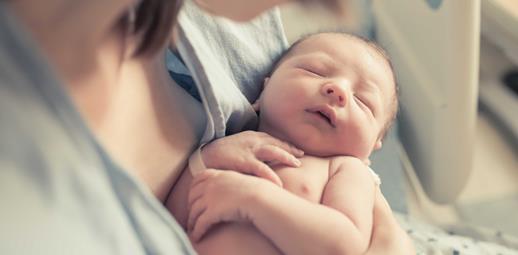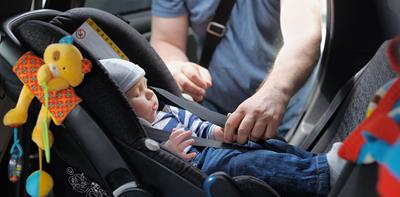
Travelling home with a newborn in a car for the first time is an exciting and joyful experience. However, it's also completely normal to feel anxious about keeping your baby safe when driving home from the hospital or birth centre.
Here we share some handy driving tips for new parents to help you prepare for that first ride home. You may find these reminders comforting and helpful in the coming weeks.
EASY AS HACK
Practice installing a car seat before travelling home with your newborn for the first time, so you feel less anxious on the day.
At a glance
Newborns shouldn’t be in a car seat for more than 2 hours at a time. In the first few weeks after birth, you should try to limit this to 30 minutes.
prepare for the journey
Give yourself plenty of time to prepare for a safe journey home with your baby. You’ll be less anxious travelling in a car with a newborn if you have packed a few travel essentials.
Keep a nappy bag and changing mat accessible in the car to change your baby along the way if needed.
Place other essentials in a bag in the boot. We can’t predict a car breaking down or an accident, but you can do everything possible to prepare yourself, including:
- A first aid kit to be on the safe side
- Warm blankets to keep your baby cosy while waiting
- Bottled water so you’re hydrated
prepare your car
Before you buckle a newborn in a car seat, it’s a good idea to get the car ready. This precaution isn’t just for your first drive home, but for every trip you take together.
To help keep your baby comfortable during car journeys, place removable sunshades or screens on the windows. Blinds protect your newborn’s delicate skin and eyes from the sun’s UV rays and glare. They are also more likely to nod off peacefully without the sun in their eyes.
Next, check for anything that might prevent you from starting your journey, like a flat tyre or a dead battery. Head over to our essential car maintenance tips before that first drive home from the hospital, and top up your fuel or charge your car battery if you have an EV.
You’ll also want to make sure your car is clean and tidy inside, with nothing loose that could fly about and hit your newborn.
install the car seat
Did you know that 7 in 10 car seats are incorrectly installed?[1] Once you have chosen the right car seat, you should learn how to safely and correctly place your little one in it. Take a moment to carefully study the manufacturer’s safety guidelines on fitting a car seat correctly.
If you’re wondering, ‘Where should a newborn sit in the car?’ The safest place is a rear passenger seat. Experts recommend rear-facing seats for babies as they offer greater protection.
- Place your newborn in a rear-facing baby seat, so they’re facing the back of the car.
- Never place a rear-facing baby or child seat in a front passenger seat with the airbag on.
- Place the car seat in the vehicle from the pavement side rather than from a busy road.
Ensure that the car seat you use is appropriate for your baby's weight category. Car seats suitable for babies are typically classified into three main groups based on weight:
- Group 0 – lie-flat baby carriers or rear-facing car seats for newborns up to 10kg (22lbs) [2]
- Group 0+ - rear-facing car seats suitable for newborns up to 13kg (29lbs) [3]
- Group 0+/1 – combination seats that are suitable from birth until your child reaches 18kg (40lbs).
Safely place your newborn in the car seat
Follow these steps on how to put a newborn in a car seat:
- Remove bulky clothing such as coats or jackets before securing your baby in the car seat. This is a critical safety measure, not just a comfort issue, as thick layers compress during a crash, causing the harness to fit more loosely than it appears. This can prevent the straps from functioning properly in an impact
- Ensure the straps are below or at your baby’s shoulder level in a rear-facing car seat to prevent them from slipping out in the event of an accident. It’s usually the lowest slot available in the seat.
- Loosen the harness straps to get your baby into the seat easily.
- Place your little one in the seat with their bottom tucked into the back of it.
- Pull the straps over their shoulders with their arms on either side as if you were putting a cardigan on them.
- Then, buckle your newborn into the car seat.
- Pull the harness tight, so there’s one finger’s width between the strap and their body. The harness should be tight enough to hold your baby firmly, but not so tight that they pinch or dig into their skin.
- Position the baby’s head straight back or to the side to help reduce the risk of airway obstruction.
Practice putting a car seat in the vehicle before your baby is born. You want to cherish every moment with your newborn, rather than spending that precious time at the hospital trying to secure the seat in place.
Plan your trip
When you’re travelling with a newborn, try to plan your trip around when your baby would typically sleep. A car’s motion often lulls babies to sleep, but they frequently nod off faster at specific times, such as immediately after a bath.
Schedule breaks in your journey to avoid your newborn sleeping in the same position for too long and to give you a chance to feed and change them.
Check your route before travelling to reduce the likelihood of stress. Knowing where to avoid traffic jams and the places where you could stop will make you less anxious.
keep your baby comfortable
Here are more suggestions for keeping your newborn comfortable when you’re travelling:
- Use window shades to shield your baby’s skin and eyes from the sun’s harmful rays.
- Ensure a comfortable temperature in the car.
- Use blankets if it gets cold.
- Check your baby’s temperature regularly (when it’s safe to do so).
what should a newborn wear in a car seat?
What your newborn is wearing can affect how well the car seat’s harness fits them, but it’s also essential to avoid them overheating. So, remove hats or outdoor clothing, such as thick coats and snowsuits, before your journey.
tips for driving with a newborn
As a new parent, your instinct will be to drive more carefully with a new infant in the back of your car. However, brushing up on your skills behind the wheel before your baby comes will give you greater confidence.
The Driver and Vehicle Standards Agency (DVSA) and Safe Driving for Life offer practice theory tests for car drivers. Alternatively, you could take it further and enrol in some refresher driving lessons.
Other tips for driving with your newborn:
- Keep the back seats clear
Don’t put your baby at risk of injury in the event of a collision by keeping the back seats clear of items like water bottles, laptops, and boxes of tissues.
Anything left on the back seat can move around while you’re driving your newborn home. Not only will it take your focus away from the road, but unsecured items can turn into projectiles in a crash.
- Don’t get distracted
Resist the temptation to constantly check on your little one by looking at them in the rear-view mirror when travelling with them. If your newborn is crying in the car seat, pull over and calm them before continuing on your travels, so they don’t distract you.
- Baby car mirrors
If you use a baby car seat mirror, ensure it’s made of soft materials and shatters upon impact. Baby mirrors are not safety tested and could become dangerous if they detach and fly about in an accident.
- Take a second adult
If possible, have a second adult in the back seat with your baby to monitor them. They can also help to keep them calm and comfortable while you drive.
- Keep your insurance updated
Ensure you have an up-to-date car insurance policy suited to your family’s needs, including breakdown cover and accident support. Find out why our car insurance is award-winning.
How long can a newborn be in a car seat?
No official rules exist regarding the maximum time a newborn can be in a car seat. However, it makes sense to avoid long periods without breaks.
The NHS recommends that babies should not be in a car seat for more than two hours.[4] In addition, this pilot study found that leaving infants asleep in car seats when not travelling can cause issues, such as higher heart and breathing rates and lower oxygen levels.
How long do you need to wait between journeys?
Again, there’s no official research. However, you should leave enough time to lift your baby from the safety seat and allow them to stretch freely. It’s safer for babies to lie flat in an appropriate sleeping environment, like a cot, as soon as you get home.
How to drive after a C-section
If you have a Caesarean section, most healthcare professionals advise you to rest for around six weeks before driving again. This advice depends on your circumstances.
Ask your midwife or GP for advice if you’re unsure when it’s safe to start driving again. You don’t need to inform your insurer if you’ve had a C-section, but medical advice matters.
Sources
[1] https://capt.org.uk/the-trouble-with-child-car-seats/

